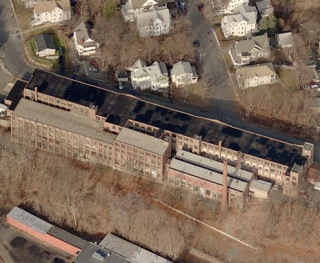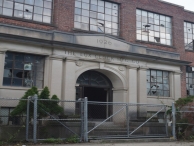Mill Record Waterbury
RETURN TO ‘FIND MILLS’Disclaimer: Content for these properties was compiled in 2014-2017 from a variety of sources and is subject to change. Updates are occasionally made under Property Information, however the Connecticut Trust for Historic Preservation (dba Preservation Connecticut) makes no representation or warranty that the information is complete or up-to-date.
- Complex Name (Common)
- Lux Clock Manufacturing Co.
- Complex Name (Historic)
-
- Lux Clock Manufacturing Co.
- Address or Location
- 95 Johnson Street, North End, Waterbury
- County
- New Haven
- Historic Designation
- Associated Mill Community
- n/a

- Historic Information
Companies Associated w/Complex
- Lux Clock Mfg. Co. 1920 to c.1970
Use (Historic)
Largest Documented Workforce
1400 (1948)
Historic Narrative
The Lux Clock Manufacturing Company was founded in Waterbury by Paul Lux in 1914. Lux had been an employee of the Waterbury Clock Company, which later consolidated with other firms to become the modern TIMEX. Lux's company started out producing movements for other manufacturers' novelty clocks. The existing factory was constructed around 1920, after a fire destroyed the original building (location unknown). While the firm undoubtedly felt the effects of the Great Depression, it still reportedly produced over 3,000 clocks per day. By the 1930s, Lux was making several lines of its own clocks. The company apparently did not experience any significant labor troubles, perhaps explained by its commitment to its workers and worker moral. In 1933, the Lux Clock Company joined several other Connecticut clock companies in the Clock Manufacturers Association of America, voluntarily entering a program of the National Recovery Administration, which guaranteed their workers an average of 40 hours per week. Like other clock makers throughout the region, the Lux Clock Company engaged in the manufacture of timing fuses used in bombs during the Second World War. In 1941, after the United States Ordnance Department declared Waterbury among the top areas for labor shortages in the country, due to the high demand on its factories for ordnance production, the U.S. Army assigned 31 enlisted men to work at the Lux factory as skilled workers with the regular labor force. Prosperity during the war proved beneficial for the company as well as the 1,400 workers at Lux, who in 1948, got significant pay increases. In 1954, additional plants were established in Lebanon, Tennessee, and Ontario, Canada. In 1958, the President and founder, Fred Lux passed away, leaving the company’s future in question. In 1961, the company was purchased by the Robershaw-Fulton Controls Company, which continued to produce clocks and timers under the name 'Lux Time Division'. In 1986, the Robershaw-Fulton Controls Company and the Lux division were sold to the Siebe Group of London, England, which continue to produce kitchen timers under the Lux name. It was likely around the time of this buyout that the Waterbury factory was closed. In 1991, the Lux name was again sold, and a new company, the Lux Company was established to produce timers and temperature control products. That company is still in business as of 2015, with its headquarters in Philadelphia, Pennsylvania.
- Architectural Information
Number of Existing Buildings
Four (4) blocks.
Dates of Construction
1920, c.1930
Architect
n/a
Builder
n/a
Building Type
Architectural Description
The former Lux Clock Company facility is composed of four blocks, the first and largest facing Johnson Street built c.1920. It is a wood frame, three-story brick building with a flat roof, approximately 455' long by 50' wide. Three additions were built in the 1930s. To the southeast of the first block is a three-story brick structure with basement and a flat roof, approximately 166' by 38'. To the southwest is a four-story brick building with a flat roof, approximately 80' by 30'. And the fourth block is a two-story brick building with a saw tooth roof with brick smokestacks which served as both a production space and the factory powerhouse, approximately 120' by 40'.
Exterior Material(s)
Structural System(s)
Roof Form
Roof Material
Power Source
Condition
Fair
Condition Notes
n/a
- Property Information
- Sources
-
Form Completed By
Michael Forino
Date
August 2015
Bibliography
- Hartford Courant.
- Chesson, Frederick W. Waterbury. Dover, N.H.: Arcadia, 1996.
- Pape, William J. History of Waterbury and the Naugatuck Valley, Connecticut,. Chicago; New York: The S. J. Clarke Publishing Company, 1918.
- Kelley, Etna M. The Business Founding Date Directory. Scarsdale, N.Y.: Morgan & Morgan, 1954.
- Representative View(s)Click on image to view full file






